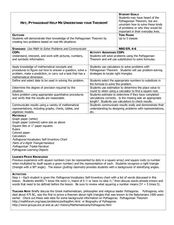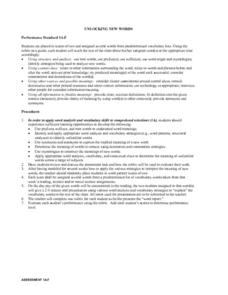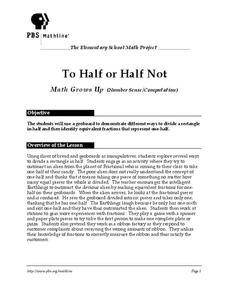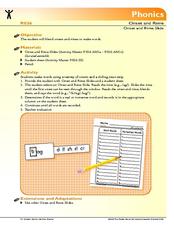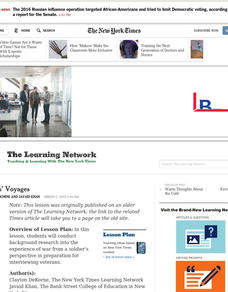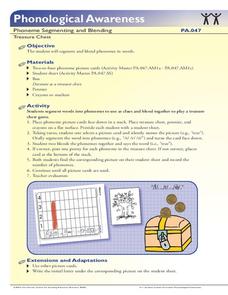Curated OER
Poetry Shopping Spree
Scholars demonstrate the ability to evaluate authors' use of literary elements such as metaphor, simile, personification, imagery, and onomatopoeia. They are provided with a checklist and must shop for poems that contain the poetry terms...
Curated OER
Hey, Pythagoras! Help Me Understand Your Theorem!
Learners explore the Pythagorean Theorem. In this math lesson, pupils solve problems using the Pythagorean Theorem. They select the appropriate numbers to substitute in the formula to solve problems.
Curated OER
Pesticide Watch Card
Students examine human health by identifying dangerous pesticides. In this agriculture instructional activity, students research the food production system in the United States and discuss dangers such as pesticides, chemicals and...
National Security Agency
A Balancing Act: Solving Multi-Step Equations
Wow! Put on that thinking cap and solve multi-step equations. To solve equations, learners review the use of the distributive property and combining like terms. This three-day lesson comes with about 20 pages of worksheets, warm-ups,...
Curated OER
Unlocking New Words: Partner Presentations
Following extensive modeling about how to apply word analysis and vocabulary skills to learn new words, partner teams create brief word presentations to teach new vocabulary to the class. Preselect words from upcoming social studies,...
Illuminations
Circumference and Areas of Circles
Middle and high schoolers listen to a scenario about a puppy and use the scenario to develop formulas in order to find the area of a circle. In this circumference lesson, pupils understand how to find the radius, diameter, area of a...
Curated OER
Drawing Portraits Using a Grid
A well-developed art lesson is always great to have around. This lesson on portrait drawing includes a full procedure, modifications, background information on artist Chuck Close, recommended websites, and a few thoughts from the...
Curated OER
Energy
Scientific terms can be difficult to remember. This resource suggests developing analogies as a way to make energy terms memorable. After listing new terms on the board, groups develop analogies based on restaurant words, and then share...
Texas Instruments
Exploring the Binomial Theorem
A comprehensive lesson that explores and researches Pascal's triangle and relates its properties to the Binomial Theorem through a variety of lessons. Have the class practice expanding polynomials using the theorem. A few other formulas...
Curated OER
What is the Setting of a Story?
First graders explore the concepts of what setting is and how it's determined in a story. They play the KidWorks program to help facilitate the setting in a story. They use resources such as a picture dictionary or word wall to find and...
Curated OER
ABC, Easy as 123
Kindergartners practice identifying the sight and sounds of vowels and consonants. They identify beginning consonants in single-syllable words and print the letters of the alphabet. This outstanding resource has many excellent...
Curated OER
The House
Oú est la cuisine? Several activities are suggested here to develop and further vocabulary acquisition for your beginning French speakers. They draw pictures of different rooms in a house and place objects around the room. Then, using...
Curated OER
Sums and Difference of Cubes
Learners factor polynomials using the sum and difference of cubes. They also learn connections between the graph and expression.
Curated OER
To Half or Half Not
Jump into equivalent fractions using these fun scenarios for mathematicians to solve. First, they use geoboards to find different ways to divide a rectangle in half. Then, an alien from the planet Fractional is after one half of their...
Curated OER
Predicting Events in Realistic Fiction
How do you make a prediction? Practice active reading comprehension strategies, like making predictions, with your readers. Learners make predictions during the independent reading of Dogs Don't Tell Jokes by Louis Sacher. They observe...
Florida Center for Reading Research
Picture the Word
This is an excellent way to make onset and rime visual for beginning readers. They examine CVC-word picture cards that are all missing the first letter. Using plastic letters (or whatever you have), they complete each word and record it...
Florida Center for Reading Research
Onset and Rime Slide
Discover onset and rime blends using this interactive activity which will appeal to your kinesthetic learners. Using the sliding templates provided, budding readers try different onsets with each rime. They practice reading skills by...
Utah Education Network (UEN)
Insides and Outsides
Give small groups handfuls of unit cubes and then dare them to build as many rectangular prisms as possible using only 12 cubes. This engaging activity serves as an introduction to the volume of solid figures. In addition to volume,...
Florida Center for Reading Research
Word Steps
Blending basic CVC letters to make words is one of the first steps to independent reading. Provided here are several images of stairs and several letters to cut and arrange. The learner rearranges the letters to form CVC patterns, sounds...
Florida Center for Reading Research
Phoneme Split and Say
Little ones are provided with all the tools needed to begin segmenting phonemes. There are twenty Elkonin box picture cards, five blank Elkonin box cards, and full instructions on how to help pre-readers practice splitting and saying...
Florida Center for Reading Research
Syllable Hopscotch
Let your little learners move while they practice breaking words into syllables or chunks. Place a hopscotch "board" on the floor (this can be done with tape). Your class takes turns choosing picture cards, and then they say the name of...
Curated OER
Veterans' Voyages
Introduce your middle and high schoolers to a different perspective on war: that of soldier's. Read Guisseppi Ungaretti's poem "Vigil" to kick-start this lesson. After discussing his perspective, read "The Screaming Eagles Fly to...
Florida Center for Reading Research
Phoneme Challenge
This phonemic awareness game is very similar to the classic card game war; partners divide picture cards, each taking half (included). They place one card face-up at a time and segment the phonemes aloud. Whoever has the most phonemes...
Florida Center for Reading Research
Treasure Chest
Segmenting and blending phonemes helps budding readers understand words. Use this strategy in an engaging game where partners test each other's auditory processing using familiar words. Using picture cards and a chart (included),...



